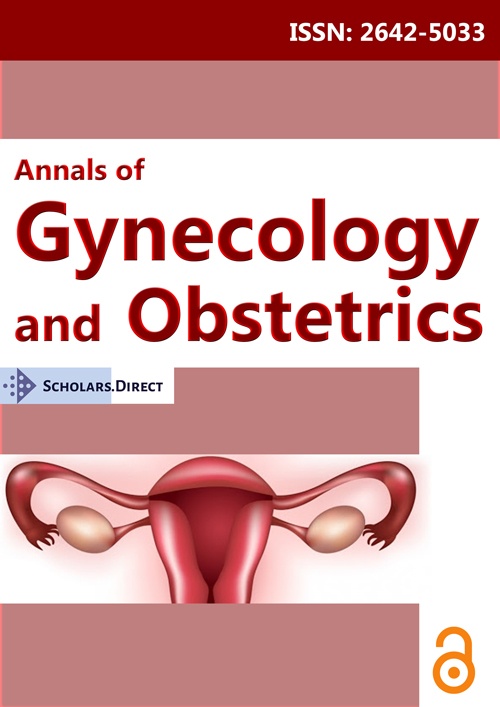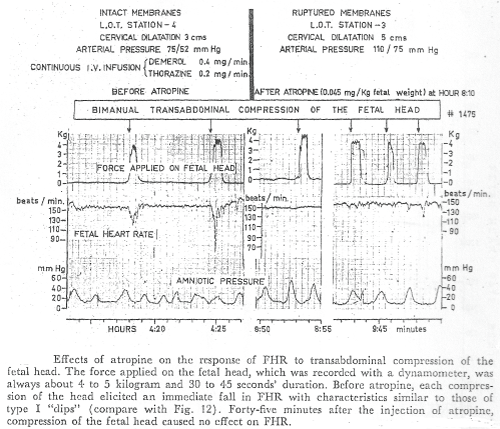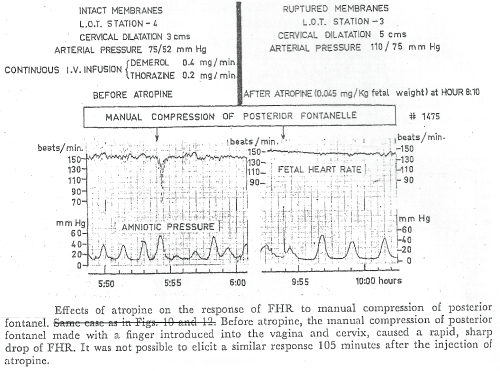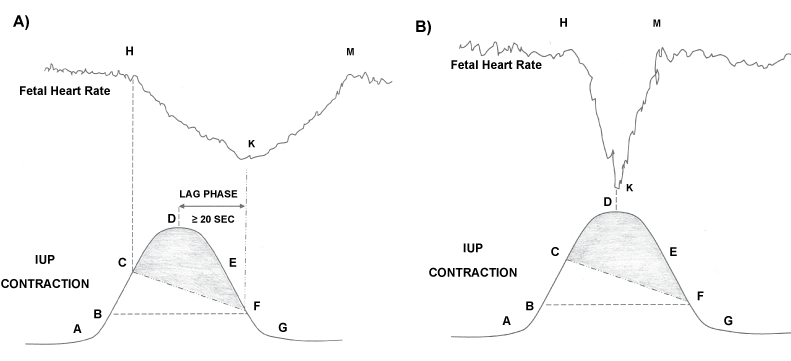Obstetrics at Momentous Crossroads Regarding Interpretation of Fetal Heart Rate Decelerations with three fateful directions - Scientific Principles and Lessons from Memetics
Abstract
The survival of cardiotocography (CTG) as a tool for intrapartum fetal monitoring seems threatened (somewhat unjustifiably and unwittingly) despite the absence of better alternatives. Fetal Heart Rate (FHR) decelerations are centre-stage (most important) in interpretation of CTG with maximum impact on 3-tier classification. Unscientific or flawed nomenclature of decelerations can explain the dysfunctional CTG interpretation leading to errors in detection of acidemic fetuses. The interpretation of FHR decelerations is inexorably linked to their nomenclature. There are three contrasting concepts about categorization of FHR decelerations 1. All rapid decelerations (the vast majority) should be grouped as "variable" because they are predominantly due to cord-compression; 2. All decelerations are due to chemoreflex from fetal hypoxemia hence their timing is not important, and 3. FHR decelerations should be categorized based primarily on their time relationship to contractions. These concepts are like memes (ideas/beliefs). Lessons from "Memetics" are that the most popular, attractive or established beliefs may not necessarily be true, scientific or even beneficial. Decelerations coincident with contractions with trough corresponding to the peak of contractions cannot be explained by mechanisms involving hypoxemia (from compromised uteroplacental perfusion, cord-compression and even cerebral hypoperfusion/anoxia purportedly conceivable from head-compression). Decelerations due to hypoxemia would be associated with delayed nadir and recovery (lag phase). Clinicians should urgently adopt the categorization of FHR decelerations based primarily on time relationship to contractions as originally proposed by Hon and Caldeyro-Barcia. This analytical review shows it to be underpinned by most robust physiological and scientific hypotheses unlike the other categorizations associated with untruthful hypotheses, irreconcilable fallacies and contradictions. Without truthful framework and meaningful interpretation of FHR decelerations, CTG is doomed as a reliable tool.
Keywords
Cardiotocography, Fetal heart rate decelerations, Memetics, Intrapartum fetal monitoring
Introduction
Fetal asphyxia in labor has devastating consequences. Cardiotocography (CTG) has been found seriously wanting in detecting fetal acidemia [1-6] but would continue to be practiced widely because alternatives like fetal ECG (ST analysis) or fetal oximetry remain unproven [6]. Hence, it seems very important to identify areas for improvement or reform of CTG interpretation. All guidelines concur on definitions of Fetal Heart Rate (FHR) baseline, variability and accelerations [4-7]. However, they differ significantly on interpretation of FHR decelerations which happen to be centre stage and critically important in interpretation of CTG [8]. When a non-acidemic fetus develops serious acidemia during labor, it invariably displays FHR decelerations reflecting or giving vital clues to its deterioration. If we don't interpret decelerations scientifically, there is little hope of interpreting CTG correctly. On the other hand, common experience shows that the majority of FHR decelerations do not lead to fetal acidemia and hence many are likely to be of non-hypoxemic aetiology. Pathophysiology and interpretation of FHR decelerations has become much contested in the last decade although there was little controversy in British practice before 2007 [9]. The very survival of CTG as a monitoring tool has been threatened following results of the INFANT trial [3] although the practical experience of most clinicians would differ. CTG interpretation will not achieve its potential until FHR decelerations are interpreted based on most scientific rationale. Obstetrics internationally has arrived at crossroads with three main paths to choose in this most vital aspect, viz. 1. All rapid decelerations (the vast majority) are due to cord-compression and hence must be called "variable"; 2. All decelerations are due to chemoreflex from fetal asphyxia (or hypoxemia) and their time relationship to contractions is irrelevant [10]; 3. FHR decelerations should be classified based primarily on their time relationship to the contractions as proposed by pioneers like Hon and Caldeyro-Barcia [9,11,12]. Only one of the three approaches must be true or correct. But does the truth matter? Although FHR decelerations are centre-stage, is their categorization/nomenclature at all important? The principle objective of this short article is to highlight the critical importance of adopting a reformed scientific categorization of FHR decelerations if the visual CTG interpretation is to survive as a clinically useful technique. This article also draws analogy from "memetics" as to how different opinions develop, disseminate and persist. Definitive quantitative or numerical proof is not a prerequisite for this analysis based on long British practice, but could follow adoption of its conclusions.
Memetics
An internationally renowned scientist Richard Dawkins in his acclaimed 1976 book "The Selfish Gene" proposed "Memetics" as a theory of "mental content" based on an analogy with Darwinian evolution. The "meme" (analogous to a "gene") was conceived as a unit of culture (an idea, belief, narrative, pattern of behaviour etc.) which is "hosted" in the minds of one or more individuals and which can reproduce itself by jumping from mind to mind [13]. The Oxford Dictionary defines memes as "replicators - tunes, ideas, catch-phrases, clothes fashions etc". Memetics is notable for sidestepping the traditional concern with the truth of ideas and beliefs. Instead, it is interested in their success. A meme's success may be due to its contribution to the effectiveness of its host [13]. Thus the meme and the host may develop a mutually beneficial relationship. Moreover, ideas (memes) can come to control thinking and people themselves. Even more revolutionary is a concept that memes like genes can spread even if the host may suffer in the process (extreme examples are kamikaze pilots and more recently suicide-bombers) [13]. Memes are replicators i.e. copied by imitation, teaching and other methods. The copies are not perfect: memes are copied with variation; moreover, they compete for space in our memories and for the chance to be copied again. Only some of the variants can survive. The combination of these three elements (copies, variation and competition for survival) forms precisely the condition for Darwinian evolution, and so memes (and hence human beliefs and cultures) evolve. Large groups of memes that are copied and passed on together are called "memeplexes" [13]. The Centre for Policy Modeling at Manchester Metropolitan University hosted an e-journal entitled the "Journal of Memetics-Evolutionary Models of Information Transmission" on the web and there has been short lived paper-based memetics publication the "Journal of Ideas" starting in 1990 [13]. Do principles of memetics apply to scientific ideas? Science should be concerned with facts and truths rather than attractiveness, popularity or chance-survival of ideas. Medicine is an applied rather than a pure science and hence memetics would have some place in it, a major one in medico-politics. One could consider the ideas and hypotheses about FHR decelerations as "memeplexes".
Critical importance of FHR decelerations in 3-tier systems
The 3-tier systems of CTG interpretation take in to account different gradations of many FHR parameters (baseline, variability, accelerations and decelerations) and arrive at a judgment viz. normal/suspicious/pathological CTG. The American 3-tier system has been found clinically unhelpful [2,14] because its pathological (Grade III) category has been designed to correlate with severe/dangerous fetal acidemia rather than less severe acidemia where diagnosis and clinical intervention should be targeted. Sometimes there is too much focus on the specific cut-offs of FHR parameters or what combinations should warrant which tier. There seems nothing definitive/sacrosanct about these. The 3-tier systems function by the macro-amalgamation of multiple parameters with varying weightage erring on the side of high sensitivity to detect moderate fetal acidemia. FHR decelerations are the most common aberrations with maximum impact on classification of CTG in the 3-tier system. Thus, rather than the variations within the 3-tier systems, the interpretation/categorization of FHR decelerations seems far more crucial [9]. It is important to note that although the loss of baseline variability has strong correlation with severe acidemia (pH 7.00) and hypoxic encephalopathy; it is seen in only a small percentage of fetuses with moderate acidemia (pH < 7.10), where obstetric intervention needs to be targeted [15,16]. Hence, more often the decision to intervene needs to be based on interpretation FHR decelerations alone (Category II of American 3-tier system) mostly without baseline changes.
Aetiological versus pathophysiological categorization of FHR decelerations
Some framework (categorization) of decelerations seems crucial/mandatory to enable structured interpretation which cannot be entirely left to clinician's discretion or "art". The precise aetiology of FHR decelerations in human labor in individual cases will mostly remain presumptive. Hence, for clinical utility the decelerations are best classified based on hypoxic or non-hypoxic nature rather than presumptive causation, the latter has caused confusion and contradictions. In the last decade it has become common to suggest that vast majority of decelerations (rapid descent) are because of cord-compression and hence must be called "variable" [5-7]. This has been mainly a result of over-simplistic adoption of observations from animal studies involving cord-occlusion which showed rapid decelerations [14]. Another (mis) belief has been that if decelerations vary in depth or width, they should be called variable [9]. But that will include all decelerations, thus an antithesis of classification. Strong empirical evidence exists that head-compression causes rapid (rather than gradual) short lasting decelerations as seen in experiments during human labor conducted by the pioneering group of Caldeyro-Barcia (Figure 1 and Figure 2) [12]. In addition, CTG records provided by Edward Hon in human labor with pressure on fetal head with ring pessaries introduced in vagina showed very similar rapid short FHR decelerations [17]. This disproves that severe cerebral hypoperfusion and unsafe hypoxia are necessary for head-compression to cause FHR decelerations [10], a belief also completely contradictory to the actual clinical experience of most obstetricians. Causation of FHR decelerations is likely to be multifactorial with head-compression making some contribution. More importantly, what seems clinically most relevant is to analyses whether the characteristics of different decelerations give clue about hypoxic or nonhypoxic mechanisms underlying them [9]. The majorities of decelerations during labor look rapid on British CTG (paper speed 1 cm/min) and coincide with contractions with trough corresponding with peak of contraction and recovering before the end of contraction [9]. Cord-compression has been suggested as underlying mechanism [5-7]. The commonly quoted baroreceptor hypothesis proposes complete cord occlusion for common benign rapid decelerations with "shoulders" [14]. This seems doubly fallacious. Complete cord-compression cannot simply be underlying cause for vast majority of decelerations in labor. Secondly, chemoreflex in response to hypoxemia is a more dominant reflex during cord-compression than baroreflex [8,10,14,18]. Moreover, the hypoxemia (hence the deceleration) will start recovering only after relief of umbilical venous compression much later during the relaxation phase and not around the peak of contraction [9,14,18].
Recently, some expert-groups have changed their previous beliefs and assertions; and come up with another school of thought that all FHR decelerations during labor are due to hypoxemia from reduction in uteroplacental perfusion (not from cord-compression after all) [10]. Fetal pulse oximetry studies show that there are milder degrees of transient fetal hypoxemia (but not acidemia or asphyxia) during most contractions, but not enough to cause FHR decelerations [10]. Hence, it has been suggested that whenever decelerations occur, they must be because of fetal hypoxemia getting worse [10]. This seems denial of all non-hypoxemic mechanisms. Further conclusion has been drawn that since all decelerations are because of hypoxemia, it is pointless to classify decelerations into "early, late and variable" as their time relationship to (peak of) contractions does not give any information [10,19]. There are major and irrevocable fallacies with this hypothesis. If fetal hypoxemia (severe enough to start a deceleration) develops during contraction phase, then this hypoxemia will not start recovering at the height of contraction (especially with increasing degrees of tissue hypoxia) but only much later in the relaxation phase (Figure 3A and Figure 3B). Thus, decelerations with their trough corresponding to peak of contraction (the majority in labor) simply cannot be explained by "hypoxemic" mechanism (due to drop in uteroplacental perfusion, cord-compression or even fetal cerebral hypoperfusion/anoxia purportedly conceivable from head-compression) as it will continue to worsen up to point F (Figure 3B). Many animal experiments show that FHR decelerations start to recover only after relief of cord-occlusion [18,20]. A select animal-preparation (confirmation bias) showing biphasic partial recovery of FHR during prolonged complete cord-occlusion [21] should not be extrapolated to human labor to explain the consistent recovery of most decelerations corresponding to the peak of contractions. These most common decelerations "early" in timing can only be explained by non-hypoxemic vagal reflex - possibly multifactorial with head-compression playing a role [9]. On the contrary the recovery of hypoxemia (and thus that of the hypoxemic deceleration) is very likely to extend beyond the end of contraction. This is in fact the classical concept of "late decelerations" quite rightly defined by RCOG as, "Decelerations with nadir more than 20 seconds (lag period) after the peak of contraction and recovery after the end of contraction" [4].
The first two schools of thought heavily depend on denial of head-compression as a mechanism for benign decelerations with liberal use of confirmation bias. They often take an absolutist view that head-compression must always or consistently cause decelerations or must explain the deceleration as a sole isolated mechanism. They propose head-compression causes decelerations only with severe compression of head with cerebral ischemia/hypoxemia (probably only in neglected obstructed labor), hence early decelerations are extremely rare [10]. Somewhat misplaced emphasis on singular aetiology has led to disproportionate importance given to sheep fetus experiments with binary methodology of artificial cord-occlusion or head-compression (at the expense of clinical experience). Findings from these animal experiments should not be directly extrapolated to much more complex and multiple factors involved during labor in clinical practice. Head-compression is very common throughout labor and can even be quite pronounced. Intrapartum fetal neurological injury due to cerebral anoxia due to head-compression in the absence of systemic hypoxemia-acidemia has simply does not seem to be a notable concern in the clinical practice and guidelines [5,6,22] despite a century of intrapartum fetal monitoring, probably for sound reasons. Surely, good evidence should be available before this theory modifies categorization of decelerations. Moreover, this is contrary to the best possible and direct empirical evidence in human labor (Figure 1 and Figure 2) [12,15]. Importantly, most birth attendants have observed head-compression causing short lasting decelerations and their experience and intuition (meme) is most likely right than the contrary meme. Particularly interesting is a common observation even mentioned by Hon [9] that during twin labor the first twin with cephalic presentation far more frequently displays rapid decelerations with early timing before and more commonly after rupture of membranes. These can be best explained by head-compression only because both twins are equally exposed to hypoxemic effects of drop in uteroplacental circulation or cord-compression [9]. The precise mechanism of head-compression decelerations is unknown but vagal stimulation due to distortion of brain envelops and transient rise in intracranial pressure could be responsible.
Thus, it seems reasonable to argue that the original categorization of decelerations by Hon and Caldeyro-Barcia based primarily on time relationship to the uterine contraction seems most scientific [9,11,12]. This was the system practiced by the British obstetricians and midwives until 2007 and is best revived.
CTG interpretation-science plus art
CTG interpretation and decision making involves analysis of complex FHR patterns in the context of materno-fetal characteristics and status of labor. In addition to scientific principles, this does involve subjective judgement and intuition - the art. However, this "art" is acquired by experience from practicing scientific concepts and framework. Senior British obstetricians often bemoan that the art of CTG interpretation is being lost but they were fortunate to have had the opportunity to learn the art in the first place by practicing traditional British system before 2007 [9]. The junior obstetricians and midwives, being exposed to unscientific framework, would be unable to acquire the art.
Does nomenclature of FHR decelerations matter?
It is a common presumption that what "label" we give FHR decelerations does not matter as long as we all practice the same standardized framework. However, this seems a misconception because the interpretation FHR decelerations are inexorably linked to their nomenclature [9]. An important tenet of science is that "the route from theory to law (framework) to measurement can almost never be travelled backwards - Thomas Kuhn, 1961". The current framework does not recognize benign early decelerations (should be more common) which is of course a major drawback. Findings of laboratory animal experiments, unrepresentative of complex multiple factors in human labor, should be interpreted with caution especially when they contradict the long clinical experience. The vast majority of FHR decelerations are (mis) labeled as "variable" due to cord-compression based on hypothesis which is fatally flawed [9,15]. A major effort gets misdirected in discriminating these (false) "cord-compression decelerations" using arbitrary, random and varied criteria depending on which guideline one refers to. But the main cause of fetal hypoxemia-acidemia in labor is contraction induced drop in utero-placental perfusion and not cord-compression at all. This distorted and unscientific framework (which mistakenly does not recognize common benign early decelerations) creates a lot of background "noise" causing false-alarm fatigue, confusion and difficulty in focusing on the smaller number of real pathological decelerations [9,12]. This has become a common theme in poor neonatal outcomes. Interestingly, when cases of birth asphyxia are reviewed in retrospect during a clinical review, investigation or medicolegal proceedings, each case gets examined in isolation and it is often easy/natural to conclude in hindsight that inappropriate action was taken despite the "abnormal" CTG which is very likely to have been present. However, in reality the grass-root clinicians would have been looking after multiple cases with several (false-positive) "abnormal" CTGs and had to select which ones to act upon based on flawed criteria. Confusion ensuing from a distorted framework and false alarms makes it difficult to "separate wheat from the chaff" thus increasing chance of erroneous decisions. Thus, unknown to the birth attendants, an enforced wrong framework (memeplex) of FHR decelerations seems to be seriously undermining their judgment/performance adversely affecting patient outcome.
It is intuitive that the "total deceleration area" will have some correlation to incidence of fetal acidemia but it requires computerized interpretation and reliable cut-offs have not been established or proven. Moreover, similar sizes of early and late decelerations will have very different significance. Hence, a methodology that incorporates both timing and size of the decelerations is likely to give improved correlation to fetal acidemia necessary for clinical usefulness.
Conclusions
Visual CTG interpretation will remain the most widely practiced method of intrapartum fetal monitoring for quite some time. The FHR decelerations are the most important, complex and contested aspects of CTG interpretation. CTG as a science will be doomed without meaningful categorization of FHR decelerations. Obstetricians and nurse-midwives need to critically analyze the three options of categorization of FHR decelerations, which are analogous to "memes" (ideas/narratives which evolve and replicate). The theory of "Memetics" explains that the popular ideas may not necessarily be true (scientific) or without harm. A framework of FHR decelerations which is based on scientific hypotheses, careful observations and valid concepts should be chosen rather than the one that has simply become "popular" (like successful memes). The categorization of decelerations into early/late/variable types based primarily on time relationship to contractions (similar to the British practice before 2007) seems to fulfill these prerequisites [9,11,12].
Declaration of Interest
The author has no conflict of interest to declare.
Contributors and Sources
This article was conceived and written by the author.
References
- Nelson KB, Sartwelle TP, Rouse DJ (2016) Electronic fetal monitoring, cerebral palsy, and caesarean section: assumptions versus evidence. BMJ 355: 6405.
- Clark SL, Hamilton EF, Garite TJ, et al. (2017) The limits of electronic fetal heart rate monitoring in the prevention of neonatal metabolic acidemia. Am J Obstet Gynecol 216: 163.e1-163.e6.
- INFANT Collaborative Group (2017) Computerised interpretation of fetal heart rate during labour (INFANT): a randomised controlled trial. Lancet 389: 1719-1729.
- Royal College of Obstetricians and Gynaecologists (2001) The use and interpretation of cardiotocography in intrapartum fetal surveillance. Evidence-based Clinical Guideline Number 8. RCOG Press, London.
- American College of Obstetricians and Gynecologists (2009) ACOG practice bulletin no 106. intrapartum fetal heart rate monitoring: Nomenclature, interpretation and general management principles. Obstet Gynecol 114: 192-202.
- www.nice.org.uk/guidance/cg190.
- Ayres-de-Campos D, Spong CY, Chandraharan E, et al. (2015) FIGO consensus guidelines on intrapartum fetal monitoring: Cardiotocography. Int J Gynaecol Obstet 131: 13-24.
- Westgate JA, Wibbens B, Bennet L, et al. (2007) The intrapartum deceleration in center stage: a physiologic approach to the interpretation of fetal heart rate changes in labor. Am J Obstet Gynecol 197: 236.e1-236.e11.
- Sholapurkar SL (2017) Critical imperative for the reform of british interpretation of fetal heart rate decelerations: analysis of FIGO and NICE guidelines, Post-Truth Foundations, Cognitive Fallacies, Myths and Occam's Razor. J Clin Med Res 9: 253-265.
- Lear CA, Galinsky R, Wassink G, et al. (2016) The myths and physiology surrounding intrapartum decelerations: the critical role of the peripheral chemoreflex. J Physiol 594: 4711-4725.
- Hon EH, Quilligan EJ (1968) Electronic evaluation of fetal heart rate. IX. Further observations on "pathologic" fetal bradycardia. Clin Obstet Gynecol 11: 145-167.
- Mendez-Bauer C, Poseiro JJ, Arellano-Hernandez G, et al. (1963) Effects of atropine on the heart rate of the human fetus during labor. Am J Obstet Gynecol 85: 1033-1053.
- https://en.wikipedia.org/wiki/Memetics.
- Sholapurkar SL (2013) Critical evaluation of American categorization of fetal heart rate (FHR) decelerations and three tier classification-Shortcomings, contradictions, remedies and need for debate. Open Journal of Obstetrics and Gynecology 3: 362-370.
- Cahill AG, Roehl KA, Odibo AO, et al. (2012) Association and prediction of neonatal acidemia. Am J Obstet Gynecol 207: 206.e1-206.e8.
- Sholapurkar S (2015) Categorization of fetal heart rate decelerations in American and European Practice: importance and imperative of avoiding framing and confirmation biases. J Clin Med Res 9: 672-680.
- Chung F, Hon EH (1959) The electronic evaluation of fetal heart rate. I. With pressure on the fetal skull. Obstet Gynecol 13: 633-640.
- Giussani DA, Unno N, Jenkins SL, et al. (1997) Dynamics of cardiovascular responses to repeated partial umbilical cord compression in late-gestation sheep fetus. Am J Physiol 273: 2351-2360.
- Ugwumadu A (2014) Are we (mis)guided by current guidelines on intrapartum fetal heart rate monitoring? Case for a more physiological approach to interpretation. BJOG 121: 1063-1070.
- Itskovitz J, LaGamma EF, Rudolph AM (1983) Heart rate and blood pressure responses to umbilical cord compression in fetal lambs with special reference to the mechanism of variable deceleration. Am J Obstet Gynecol 147: 451-457.
- MacLennan A (1999) A template for defining a causal relation between acute intrapartum events and cerebral palsy: international consensus statement. BMJ 319: 1054-1059.
- Lear CA, Galinsky R, Wassink G et al. (2017) Reply from Christopher A Lear, Robert Galinsky, Guido Wassink, Kyohei Yamaguchi, Joanne O Davidson, Jenny A Westgate, Laura Bennet and Alistair J Gunn. J Physiol 595: 6081-6083.
Corresponding Author
Shashikant L Sholapurkar, MD, DNB, MRCOG, Obstetrician and Gynecologist, Royal United Hospitals Bath NHS Foundation Trust, Combe Park, Bath, UK, Tel: 44(0)1225428331.
Copyright
© 2017 Sholapurkar SL. This is an open-access article distributed under the terms of the Creative Commons Attribution License, which permits unrestricted use, distribution, and reproduction in any medium, provided the original author and source are credited.







